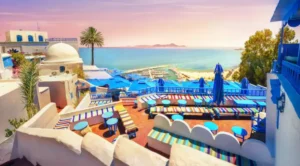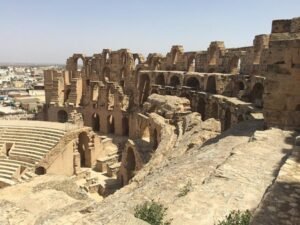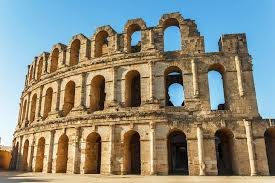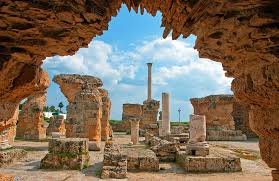



THE BEST PLACES TO VISIT IN TUNISIA is not just a tagline — it is an invitation. In 2025, Tunisia stands as one of North Africa’s most compelling travel destinations. From sun-drenched Mediterranean beaches to wind-blown desert dunes, from the mosaic-clad walls of Roman cities to narrow alleys of Islamic medinas, the country offers a vivid tapestry of landscapes, cultures, and histories. In this article, we journey through Tunisia’s top destinations — the best places to visit in Tunisia — blending personal impressions, descriptive narrative, and factual grounding. Whether you are planning a trip, writing a research paper, or simply dreaming of escape, this article aims to open doors into Tunisia’s many wonders.
Tunisia at a Glance: Geography, History & Travel Context
Before diving into specific sites, it helps to place Tunisia in context — its geography, key historical layers, and travel logistics.
Geography and Regions
Tunisia is the northernmost country of Africa, its northern coast washed by the Mediterranean Sea. It is relatively small (roughly 164,000 square kilometers), yet internally diverse: fertile coastal plains to the north, the丘Dorsal (the eastern Atlas foothills) in the center, and the Sahara desert zone to the south. The boundaries between these zones are gradual rather than abrupt, which allows travelers to traverse from sea to desert in a matter of days.
The country is often divided into these broad sectors:
-
Northern & Coastal Tunisia: This includes Tunis, Bizerte, Cap Bon, Hammamet, Sousse, Monastir, Mahdia, and the Gulf of Gabès. This is the zone of Mediterranean beaches, seaside resorts, and historic towns.
-
Interior & Highland Tunisia: The hill country, olive groves, ridge zones, and towns such as Kairouan, Zaghouan, and the interior oases.
-
Southern & Saharan Tunisia: From Tozeur, Douz, Matmata, and the grand oases (Ksar Ghilane) into the border dunes. This is where the Sahara begins to dominate, with desert oases and stars.
Because Tunisia is relatively compact, many of the best places to visit in Tunisia can be visited sequentially on a road trip.
Historical Layers
One of the great appeals of Tunisia is how many civilizations have left their marks:
-
Punic / Carthaginian era: Carthage and the Phoenician influence (9th century BCE onward).
-
Roman era: After Rome’s destruction of Carthage in 146 BCE and the establishment of the province of Africa, many Roman cities — theatre, baths, villas, mosaics — arose. The best preserved include El Jem, Dougga, Bulla Regia, etc.
-
Byzantine / Vandal / late antiquity: Transitional layers between Roman and Islamic rule.
-
Islamic era & medieval dynasties: The Islamic conquest (7th century onward), the Aghlabids, Fatimids, Zirids, the Hafsids, and later Ottoman influence.
-
Ottoman & local beyliks: The Ottoman era left architectural legacies, the kasbahs, fortresses, and also influenced urban patterns.
-
French protectorate and modern Tunisia: From 1881 to independence in 1956, French colonial rule introduced new urban planning, infrastructure, and also tensions that shaped the modern state.
Thus when you stand in a Roman amphitheater, wander in a 9th-century mosque, and then rest under palm trees in the desert, you are walking layers of millennia in a few hours.
Travel & Infrastructure in 2025
As of 2025, Tunisia remains one of the more established tourist circuits in North Africa. Some practical notes:
-
Airports & Entry: Tunis–Carthage International Airport is the main hub. There are also airports at Djerba, Monastir, and others that receive regional and European flights.
-
Roads & Transport: The coastal highway (RN1) links many of the Mediterranean towns. Inland roads vary — in the south, 4×4 or sturdy rental vehicles may be needed. Shared minibuses (“louages”) serve many towns. Many tours operate between key sites.
-
Safety & stability: Over recent years, Tunisia has worked to increase security and reassure tourists. Certain areas (particularly in the far south bordering Libya or Algeria) may require local guidance or restrictions.
-
Best times to visit: Spring (April–June) and autumn (September–October) are ideal. Summers are hot on the coast and extremely hot in the desert. Winters are mild along the coast, chilly inland and desert at night.
-
Cultural norms: Tunisia is relatively liberal among Arab countries. Dress modestly in religious settings. Arabic is the national language; French and some English are widely understood in tourist areas.
With that foundation, let us now proceed to the heart of this article: a curated tour of THE BEST PLACES TO VISIT IN TUNISIA in 2025, from beaches to ancient ruins and desert oases.
Coastal and Beach Destinations: Sun, Sea & Relaxation
When people imagine Tunisia, often they picture Mediterranean beaches — azure sea, palm-lined promenades, fishing boats, cafés. And indeed, several of the best places to visit in Tunisia are along its coastline. Below are some must-see beach and resort areas, paired often with historic or cultural sites nearby.
Hammamet & Cap Bon Peninsula
(H2) Hammamet and Cap Bon: Among the Best Places to Visit in Tunisia for Beaches and Culture
Located on the Gulf of Hammamet, the town of Hammamet is one of Tunisia’s classic seaside destinations. Its broad crescent of golden sand is lined with hotels, gardens, and promenades. In the summer, Hammamet becomes a hub of resort life — sun loungers by day, cafes and nightlife by evening.
But beyond the beach, Hammamet offers a medina quarter with whitewashed walls, narrow lanes, and artisan workshops. Nearby, the Cap Bon peninsula features citrus orchards, fishing villages, and olive groves. Many travelers day-trip to Kelibia, Nabeul, and Kerkouane (a Punic ruin on Cap Bon). Hammamet is so well established as a beach destination that some call it “Tunisia’s Saint-Tropez” (an accolade mentioned in travel press) The Sun.
From Hammamet, it is easy to access other coastal towns and major inland sites, making it a great base.
Sousse & Port El Kantaoui
(H2) Sousse & Port El Kantaoui: A Blend of Beach Life and Historic Charm
South along the coast lies Sousse, one of Tunisia’s busiest and most vibrant coastal cities. It combines beaches, resort hotels, and a dynamic historic heart. The old Medina of Sousse is a UNESCO World Heritage site, full of ramparts, souks, and the Ribat fortress (a monastic fortress). Walking through its alleyways one glimpses Moorish arches, mosaics, and lively market stalls.
Just north of Sousse is Port El Kantaoui — a purpose-built tourist resort with a marina, hotels, golf courses, and recreational facilities. The architecture is modelled in a stylized “Tunisian medina” style, with cobbled streets, seafront terraces, and narrow passageways. Wikipedia While critics sometimes describe Port El Kantaoui as artificial or soulless, for many travelers it offers convenience, beach access, and resort amenities.
From Sousse or Port El Kantaoui you can also reach inland sites like El Jem or Kairouan on day trips.
Monastir & Mahdia
(H2) Monastir, Mahdia & the Gulf of Monastir: Quiet Beaches and Historic Vestiges
Further south along the coast, Monastir and Mahdia offer a more relaxed, less tourist-crowded vibe. Monastir’s old town and Ribat (fortified monastery) stand as reminders of its importance in Islamic North Africa. The seafront promenade, yacht harbor, and beaches make it a pleasant coastal stop.
Mahdia is known for its broad white beaches and more tranquil ambiance. Visitors enjoy walking the old peninsula, exploring ancient walls, and relaxing by the sea in less frenetic surroundings.
Djerba Island
(H2) Djerba: An Island of Beaches, Culture & Heritage
Further to the south, Djerba is a gem — an island off Tunisia’s southeast coast, connected by causeway. It is known for its long white beaches, palm groves, and relaxed island life. In addition to the beach, Djerba has intriguing cultural and historical sites.
One such site is Borj El Kebir (also known as Borj Ghazi Mustapha), a fortress in Houmt El Souk (Djerba’s main town). The castle, built in part in the 14th century on older ruins, now serves as a museum with a commanding view of the harbor and is one of the best visited historical sites on the island. Wikipedia
Djerba also has Jewish heritage (the historic El Ghriba synagogue), local markets, and crafts. The island atmosphere, with slower pace and abundant beach time, makes it among the best places to visit in Tunisia for relaxation.
Historic City Centers & Medinas
No visit to Tunisia is complete without wandering the old quarters — the medinas, mosques, madrasas, souks, and hidden courtyards. Below are key urban historic sites that belong to the best places to visit in Tunisia.
Tunis & the Medina of Tunis + Bardo Museum
(H2) Tunis: Capital, Medina & Bardo Museum — A Top Place to Visit in Tunisia
The capital, Tunis, serves as an essential starting point for many visitors. The medina of Tunis is a UNESCO World Heritage site, with narrow alleys, bustling markets, architecture from Fatimid, Hafsid, Ottoman periods, and hidden mosques, madrasa, and fountains. It is easy to lose oneself in its labyrinthine streets.
A must-visit adjacent to the city is the Bardo Museum, one of North Africa’s great museums. It contains one of the world’s richest holdings of Roman mosaics, along with Punic, Islamic, and Ottoman artifacts. Many of the mosaics originally were from Roman villas all across Tunisia. The museum’s impression is that layers of civilization have been carefully preserved in glass cases and stone exhibits.
From Tunis, you can also visit the archaeological site of Carthage (just a few kilometers away), the ruins of the Punic and Roman city. Many day tours connect Tunis, Carthage, Bardo, and the northern coast.
Kairouan
(H2) Kairouan: The Holy City and Among the Best Places to Visit in Tunisia
Inward from the coast lies Kairouan, considered the fourth holiest city in Islam and a UNESCO World Heritage site. Kairouan’s Great Mosque (Masjid Uqba) is a venerable, sprawling mosque with a forest of columns, majestic courtyard, and austere elegance. Visiting its prayer halls, courtyard, and minaret is a highlight. The city also contains numerous zaouias (shrines), modest medina quarters, and a reputation for beautiful carpets and local crafts.
Because of its religious significance and architectural beauty, Kairouan often ranks high on lists of best places to visit in Tunisia for travelers wanting depth beyond beach resorts.
Sousse Medina
(H2) The Medina of Sousse: Fortified Walls, Souks & Historic Depth
While Sousse is appreciated as a beach town, its old town (the Medina of Sousse) is itself a gem. Surrounded by fortifications and towers, it contains the Ribat (fortress), Great Mosque, souks, narrow streets, and the Sousse Archaeological Museum. Walking the ramparts at sunset offers spectacular views over sea and city. The blending of beach life with historic immersion makes the Medina of Sousse a must on many Tunisia itineraries.
Roman & Ancient Ruins: Where Empires Speak
One of Tunisia’s greatest strengths is the number and quality of its ruins from the Roman and earlier eras. These sites are often among the best places to visit in Tunisia for archaeology enthusiasts and history lovers. Below are some of the most important and evocative.
El Jem Amphitheatre
(H2) El Jem: The Roman Amphitheatre — A Top Place to Visit in Tunisia
At the heart of Tunisia’s Roman heritage sits El Jem (also spelled “El Djem”) — home to an astonishing and remarkably preserved amphitheater. Built around 238 CE, the Amphitheatre of El Jem could seat approximately 35,000 spectators. It is one of the largest Roman amphitheaters in the world and second only to Colosseum in Rome in scale within the region. Wikipedia+2TravelTriangle.com+2
What makes El Jem especially compelling is how intact it remains. Visitors can walk inside, view the arena, and see chambers below. In late afternoon light, the stone glows golden, and one imagines gladiatorial contests, processions, or spectacles of antiquity.
Because of its magnificence and preservation, El Jem is undoubtedly one of the best places to visit in Tunisia and often features high on cultural-heritage itineraries.
Dougga (Thugga)
(H2) Dougga (Thugga): The Best Roman Ruin in Tunisia
Perhaps the most ambitious of Tunisia’s Roman ruins is Dougga (ancient Thugga), located inland north of the capital. Dougga is often touted as “the best preserved Roman city in North Africa” because its ruins — theaters, capitol, temples, baths, houses — spread across a hillside overlooking olive groves. Gokite Tours and Travels+3Goway Travel+3El País+3
In 2025, Dougga was highlighted in news coverage as one of the top Roman sites in Africa. El País The site includes over 70 hectares and has remains from Punic, Numidian, Hellenistic, and Roman phases. The theater, temple of Saturn, capitol, triumphal arch, baths, and a church (Vandal–Byzantine era) combine to tell complex layers of history.
Visiting Dougga is like walking through history: terraces, columns, inscribed stones, views of valleys and groves. It is widely considered essential for anyone interested in the best places to visit in Tunisia.
Bulla Regia
(H2) Bulla Regia: Subterranean Roman Houses & Mosaic Beauty
In northwest Tunisia near the Algerian border lies Bulla Regia, known for its semi-underground Roman houses — built to provide thermal relief in summer heat — and exquisite floor mosaics. Some houses are partially underground, with columns, peristyles, and preserved mosaics that give glimpses into Roman domestic life. Because fewer crowds reach this site, it offers a contemplative, less visited contrast to El Jem or Dougga. Several mosaics are displayed in situ; others were relocated to the Bardo Museum.
Carthage & Punic Ports
(H2) Carthage: From Punic Power to Roman Metropolis — A Top Place to Visit in Tunisia
Just outside Tunis lies the storied site of Carthage — once rival to Rome, later incorporated into the Roman empire, and long a symbol of Mediterranean power. Though much is ruined or buried, key elements remain: the Antonine Baths, Roman theatre, Punic ports, Punic tophets, and the Carthage National Museum. TravelTriangle.com+2Goway Travel+2
Carthage is often included in guided loops around Tunis. The site offers sweeping views over the sea and remains of walls and stone ruins. It bridges the Punic and Roman eras, giving perspective to Tunisia’s layered heritage.
Kerkouane
(H2) Kerkouane: The Rare Punic City Unabandoned by Romans
A lesser-known but fascinating ruin is Kerkouane, located on the Cap Bon peninsula. Unlike many Punic sites that were rebuilt by Romans, Kerkouane was abandoned before substantial Roman reconstruction, making its remains uniquely “Punic” in style. Archaeologists and tourists alike find it invaluable for studying Phoenician-Punic architecture and urban planning. Some recent travel accounts and articles highlight Kerkouane in lists of historical stops in Tunisia. El País
Desert Oases, Ksour & Southern Tunisia
From beaches and ruins we now move inland and south, where beauty is sparser, horizons are wider, and encounters feel adventurous.
Ksar Ghilane Oasis
(H2) Ksar Ghilane: Oasis, Hot Spring & Desert Gateway
One of the most striking of the best places to visit in Tunisia is Ksar Ghilane, an oasis in southern Tunisia at the edge of the Great Erg Oriental (Saharan dunes). The oasis contains date palms, a hot spring where you can bathe, and the ruins of a Roman castellum (Roman border fortification) known as Tisavar, partially buried by sand. Wikipedia
In 2025, Ksar Ghilane remains a favored gateway into the desert. Visitors can stay in tented camps, take jeep or camel rides through dunes, enjoy starry nights, or ride ATVs. The juxtaposition of cool spring water, desert sand, and ancient walls is unforgettable.
Matmata & Troglodyte Homes
(H2) Matmata: Troglodyte Homes & Berber Memory
In the more immediate south, Matmata is famous for its troglodyte dwellings — homes dug into soft rock, sometimes into deep pits, with subterranean rooms. While popularized in modern times as “Star Wars homes,” the traditional Berber practice of troglodyte architecture preceded film sets. Visitors can tour inhabited caves, visit small villages, and see how local people adapted to extreme climates.
Ksour — Ksar Ouled Soltane, Ksar Hallouf, Douiret, Chenini
(H2) Ksour and Berber Villages: Ksar Ouled Soltane, Ksar Hallouf, Douiret & Chenini
“Ksour” (plural of ksar) are fortified granaries or small fort-villages built by the Amazigh (Berber) peoples, often comprising ghorfas (vaulted grain chambers). Some ksour also served as community centers. They are concentrated in southern Tunisia and along the route to the desert.
-
Ksar Ouled Soltane and Ksar Hadada are among the more famous, partly because they were used as filming locations for Star Wars. Many visitors climb stairways between ghorfas, exploring the multi-level storage chambers. (See detailed travel accounts in guides) Nicki Posts Travel Stuff+1
-
Ksar Hallouf is less visited, perched on a hill, with an intimate feel. Nicki Posts Travel Stuff
-
Douiret is an ancient, partially abandoned Berber village with crumbling stone houses, narrow alleys, and impressive vistas across the desert. Nicki Posts Travel Stuff+1
-
Chenini is built into the slope of a hill, with terraced houses, pathways, and traditional life continuing in parts of it. Nicki Posts Travel Stuff
Walking through these ksour feels like stepping into another era: dry stones, wind-swept alleys, the silence of desert margins.
Tozeur, Chott el-Djerid & the Oasis Circuit
(H2) Tozeur & the Oasis Circuit: Gateway to the Deep South
Tozeur is an oasis city in southwest Tunisia, famous for its palm groves, mud-brick architecture, and proximity to the Chott el-Djerid (a vast salt lake). The reflective surfaces of the salt flats, especially at morning or evening, suggest endless horizons and stark beauty. Nearby are old palaces, labyrinthine medinas, and the Mides/Tamerza/Zeïda oases circuit — gorgeous gorges, waterfalls, and desert springs.
From Tozeur one can venture further toward the Algerian border or deeper into dunes.
Thematic & Experiential Stops
Beyond simple lists of places, some experiences help bring Tunisia’s textures alive. Below are thematic stops or modes that enhance a trip through the best places to visit in Tunisia.
Star Wars Filming Sites
(H2) Star Wars in Tunisia: Mos Espa, Lars Homestead, and Beyond
Fans of Star Wars have long known that parts of Tatooine were filmed in Tunisia. Certain sites — like Mos Espa (a desert “set” outside Tozeur), the Lars Homestead dome in Chott el-Djerid, and interior sets in Matmata — attract movie buffs and curious travelers alike. Nicki Posts Travel Stuff+2TravelTriangle.com+2
Exploring these sites is not just about Star Wars nostalgia — it’s about noticing how filmmakers used natural dunes, salt flats, rocky outcrops, and local architecture to evoke alien worlds. The contrast between local life and cinema fantasy is fascinating.
Birdlife, Wetlands & Nature Reserves
(H2) Ichkeul, National Parks & Wetlands: Natural Side of Tunisia
Tunisia’s natural heritage is sometimes overshadowed by its historical attractions, yet it offers remarkable biodiversity and ecosystems — especially in the north and central zones.
One major site is Ichkeul National Park, a UNESCO World Heritage site, featuring a wetland-lake system that serves as a stopover for migratory birds. Marshes, reedbeds, seasonal flooding, and mountain backdrop make it compelling for bird watchers and nature lovers.
Research on biodiversity conservation in central Tunisia’s mountainous landscapes highlights how ecological zones, fragile mountain environments, and human pressures intertwine. arXiv
Elsewhere, desert-fringe zones host hardy plant species, oasis ecosystems, and unique microclimates in places like the central ridge or highlands. For travelers, these natural areas offer contrast with ruins and sea, and serve as reminders of the living landscape.
Zoos, Parks & Wildlife Encounters
(H2) Friguia Park & Wildlife: A Break from Ruins and Sand
For families or those seeking a break from ruins, Friguia Park (near Bouficha, between Tunis and Sousse) is a zoological park housing around 400 animals of 62 species — mammals, reptiles, birds, etc. Wikipedia It includes picnic areas, educational programs, and is accessible by road from major coastal towns.
While not on every traveler’s list, such parks provide worthwhile interludes and context for Tunisia’s living biodiversity.
Suggested Route & Sample Itineraries
To make this more actionable, here are sample routes and itineraries for different trip durations — each hitting many of the best places to visit in Tunisia.
7-Day Coastal & Historic Highlights
-
Day 1: Land in Tunis, explore the Medina, Bardo Museum
-
Day 2: Day trip to Carthage, Sidi Bou Said
-
Day 3: Travel to Kairouan; explore mosques and local crafts
-
Day 4: Head to Sousse, visit Medina, enjoy beach
-
Day 5: El Jem amphitheater, then onward to Mahdia
-
Day 6: Travel to Monastir, relax by the sea
-
Day 7: Return to Tunis or connect to Djerba
This route emphasizes beaches, cities, and one major Roman ruin.
10-Day Historic + Ruins + Desert Mix
-
Days 1–3: Tunis, Carthage, Bardo, Kairouan
-
Day 4: Dougga (ancient ruins)
-
Day 5: Head south toward Sousse / Monastir
-
Day 6: El Jem
-
Day 7: Matmata, troglodyte homes
-
Day 8: Tozeur, Oasis circuit
-
Day 9: Ksar Ghilane, overnight desert camp
-
Day 10: Return via Djerba or desert route
This mix gives coastal, historic, and desert highlights.
Extended 14+ Day Immersion
For deeper travelers, include more ksour (Douiret, Chenini), Bulla Regia, Kerkouane, island of Djerba, more desert exploration (further into Algerian border regions with guides), and wildlife/nature reserves. You could also circle the interior ridge or cross the country east to west.
Travel Tips & Practical Advice
To optimize your trip and avoid pitfalls, here are practical tips based on recent travel experience and guides.
Accommodation & Camping
-
In coastal and major towns, you’ll find hotels from budget to luxury.
-
In desert areas (Ksar Ghilane, deep south), tented camps or guest-houses are common; book ahead if traveling in high season.
-
Some ksour may offer guest rooms in renovated ghorfas, but lodging is often minimal.
-
For archaeological towns (Dougga, Bulla Regia), overnight lodging may require staying in nearby towns or base along main roads.
Transportation
-
Rent a car (preferably 4×4 if going south) to have flexibility, but local traffic and signage can be variable.
-
Use louage (shared vans) for intercity links where possible.
-
Tours: For desert segments or for ruins like Dougga, hiring local guides or joining small group tours can maximize insight.
-
Check condition of roads especially in southern Tunisia after rains — some tracks may be washed or sanded over.
Permits, Entry & Guidance
-
Most ruins require an entrance ticket; bring identification.
-
In some remote desert or border regions, local permissions or guides are necessary for safety.
-
Respect restricted zones and check local advice (especially near borders).
-
Hire local guides at major archaeological sites to enrich your understanding; many inscriptions or wall fragments are interpretable only with expert help.
Best Time to Visit & Weather
-
Spring (April–June) and autumn (September–October) are ideal: comfortable temperatures, fewer tourists, and agreeable desert conditions.
-
Summer (July–August) can be scorching, especially inland and in the south; coastal zones may be tolerable.
-
Winter is mild on the coast but nights in desert and inland zones can be cold.
-
Days are long in summer, shorter in winter; plan daylight usage accordingly.
Packing Tips
-
Lightweight, breathable clothing (with layers for cooler nights).
-
Sun protection: hat, sunscreen, sunglasses.
-
Good walking shoes for uneven terrain and ruins.
-
Water bottles, hydration gear, medical kit.
-
A power bank, chargers, local SIM or eSIM.
-
A good field guide or app (archaeology, birds, plants) to deepen your engagement with sites.
-
Drone (if allowed) or camera — many aerial angles of ruins and dunes are spectacular (check local regulations).
Cultural Etiquette
-
In religious spaces, dress modestly (cover shoulders, knees).
-
Be polite, ask before photographing people.
-
Bargaining is customary in souks, but keep respect.
-
Learn a few Arabic or French phrases — welcome, thank you, etc.
-
Respect local rules in remote and sacred spaces; some areas might restrict access.
Why These Sites Are “Best”: Themes & Criteria
You may ask: why is this list of the best places to visit in Tunisia justified? What criteria unify them? Here are some guiding principles:
-
Historical & archaeological significance: Places like El Jem, Dougga, Carthage, and Bulla Regia represent major layers of Mediterranean civilization.
-
State of preservation & visitor experience: Sites that are well preserved or have visible, interpretable remains (theaters, mosaics, ghorfas) allow deeper engagement.
-
Scenic & geographic variety: The best places include beach, desert, oasis, mountains, wetland — giving variety of landscapes.
-
Accessibility & infrastructure: While remote sites enrich adventure, a balance with reachable ones ensures realistic travel.
-
Cultural immersion & living communities: Many of these places are not museum relics but living towns — medinas, ksour, Berber villages — where life continues and interacts with heritage.
-
Complementarity: A good itinerary mixes types: beaches and downtime, cities and medinas, ruins and nature, desert and forests.
By these lenses, the places in this article stand out as the richest, most engaging, and most memorable among Tunisia’s many offerings.
Further Research & Study
If you (or your readers) wish to dive deeper beyond travel, here are topics and resources worth exploring, tied to the places above:
-
Roman Africa & the provinces: The architecture, inscriptions, and urban planning of Roman Tunisia merit serious archaeological study (e.g. in El Jem, Dougga).
-
Punic / Phoenician urbanism: Sites like Carthage and Kerkouane allow study of Phoenician city planning and its transformation under Roman rule.
-
Berber & Amazigh culture: The ksour, troglodyte houses, and desert communities invite ethnographic and anthropological work.
-
Environmental & biodiversity studies: Ecosystems such as Ichkeul, mountain landscapes in the Tunisian Dorsal, desert edge flora/fauna are active research areas (see for example recent work on biodiversity in central Tunisia) arXiv.
-
Tourism, heritage management & sustainable development: How Tunisia balances heritage preservation, tourism impact, and local needs is a case study in many planning circles.
-
Film & media geography: The Star Wars filming locations raise questions about cinematic imaginaries, place making, and cultural tourism.
For further engagement, you might build an annotated map of the sites above, or cross-reference them with academic publications and archaeological reports. For example, UNESCO’s listings of Tunisia’s World Heritage sites provide official data and priorities.
Also, if you enjoyed this layout and narrative style, you might compare this article to similar posts on places in other African nations — for example, check out my article on Malawi:
https://jetsettrail.com/the-best-places-to-visit-in-malawi/
Conclusion
In 2025, Tunisia continues to reward travelers who bring curiosity, flexibility, and patience. From the sparkling Mediterranean shores to the silent dunes of the Sahara, from Roman amphitheaters to Berber ksour, the country offers an extraordinary density of experience in a relatively small land. The sites presented in this article represent a pathway through the best places to visit in Tunisia — but they are not the only ones. Every valley, village, or ruined arch may hold surprises.
If you decide to explore Tunisia, I encourage you to immerse beyond postcards — to linger in a medina alley, to join a local guide at dawn in a desert camp, to trace mosaic tessera by hand, to sit under palm trees in silence. That is when the soul of Tunisia reveals itself.


